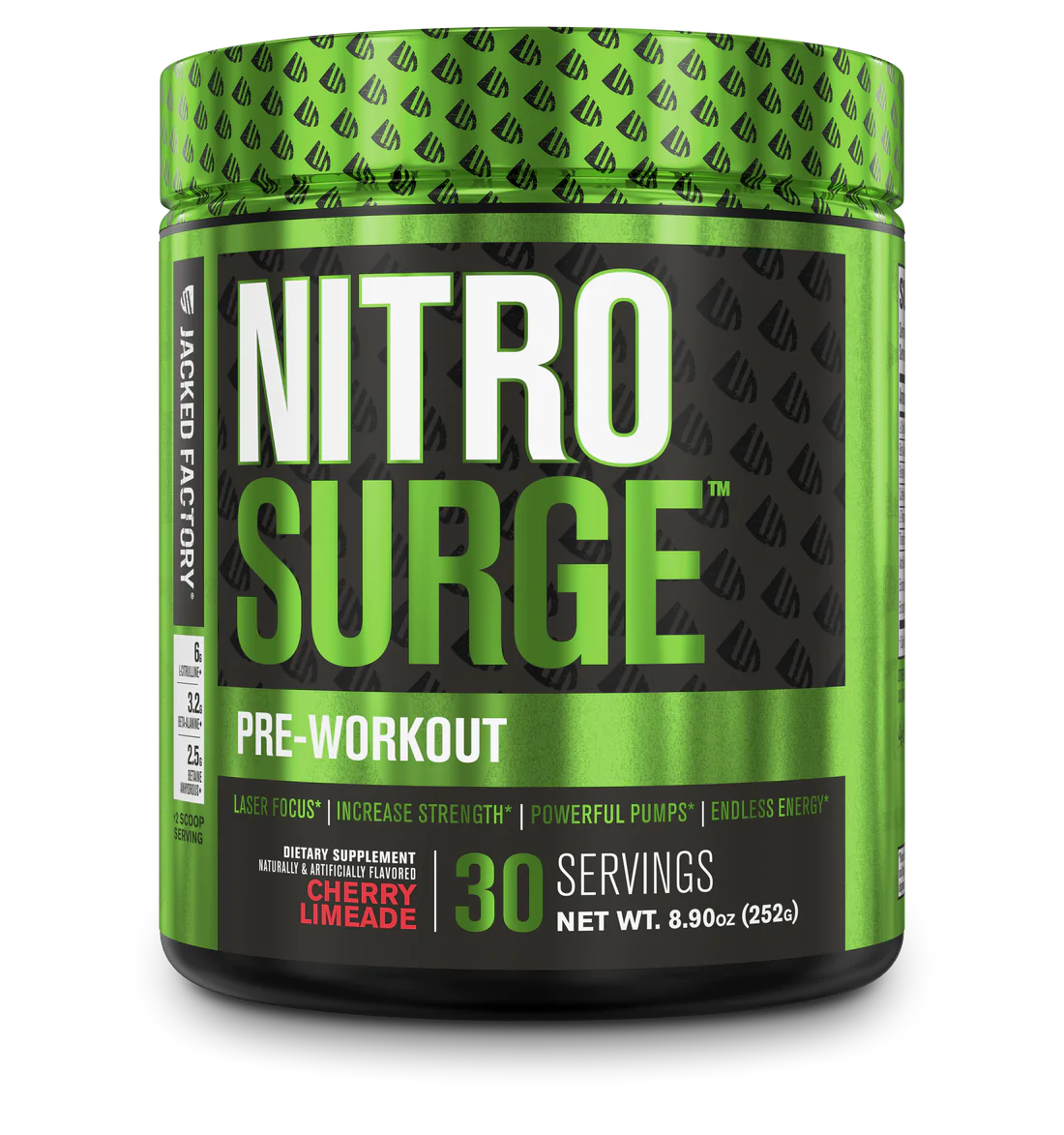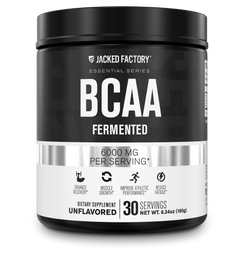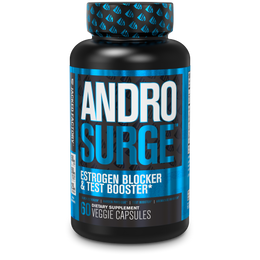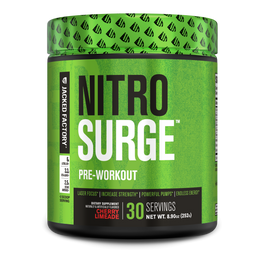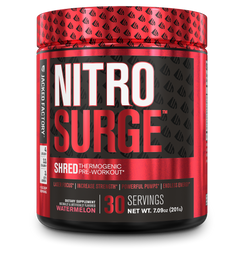How to Get in Shape and Beach-Ready
Memorial Day is right around the corner, and that means the summer season is fast approaching. With COVID on the downtrend (knock on wood), this summer is poised to be full of beach festivities.
But if you're like many others, COVID probably threw off your fitness and physique goals. Don't worry; it's been a tough year for everyone. If you unwillfully put on a few pounds during the pandemic, you're certainly not alone.
The good news is that you can get back in shape quickly with a proper diet and exercise regimen. So, are you ready to get the beach body of your dreams and be healthier? If so, this guide is for you! We'll show you how to get in shape (and stay in shape) using evidence-based nutrition, lifestyle, and supplement strategies.
Weight-Loss Nutrition: The Key to Getting in Shape Quickly
Summer is almost here, so there’s no time to waste! Let’s jump right into the main dietary factors that impact fat loss, including calorie intake (energy balance), macronutrient intake, nutrient timing, and food choices. These are the foundation of getting in beach-ready shape, and it’s essential to prioritize them if you want to lose weight and feel your best.
Determining How Many Calories to Eat for Fat Loss
Scientific and clinical studies make it clear that energy balance is the most important regulator of weight loss and body composition [1]. If you consistently eat too many calories relative to how many you burn, you will not lose weight or body fat. It's that simple.
Therefore, the first (and most important) step to getting beach-ready is determining how many calories you should eat. While there is no 100% accurate equation for determining your calorie needs, you can get a good estimate by multiplying your lean body mass (in pounds) by 13 if you’re female or by 14 if you’re male (if you're a very active person, add an extra 10%.). That will give you a ballpark idea of how many calories to eat for fat loss.
For example, a 200-lb man with roughly 15% body fat has about 170 lbs of lean body mass. So, his starting fat-loss calorie goal will be: 170 x 14 = 2,380 calories per day.
Follow your starting calorie goal for at least two weeks, assess your progress and recalculate as necessary. Remember, these calculations are meant to serve as an initial guideline.
You will likely need to make some adjustments and fine-tune your actual calorie intake as you progress and learn more about your body’s response to a weight-loss diet.
Now, the question remains: How much protein, fat, and carbs should you eat to lose weight?
Macros for Fat Loss
To reiterate, calories are the most important factor for burning body fat. However, macronutrient (e.g. carbohydrates, protein, and fat) intake is also a major component of fat loss.
There is no cookie-cutter macro breakdown that’s optimal for everyone trying to lose weight. Some people respond better to higher carb intake; others respond better to lower carb intake. However, most people see great fat loss results when following a high-protein, low-carb, moderate-fat diet. Try different macro approaches and see what works best for you.
Suggested Macro Guidelines for Fat Loss

If you’re the no-frills type, then we suggest using the following macro guidelines to get you started on the right foot:
Protein: 1.2-1.4g/lb of bodyweight
- Example: A 160-lb person should aim for roughly 190-225 g protein per day (protein has 4 calories per gram), so this person should consume about 760-900 of their calories in the form of protein.
Fat: 25%-30% of your total calorie intake
- Example: A person with a calorie goal of 2,200 calories per day would aim for about 550-660 calories from fats (fat has 9 calories per gram), so this person should eat roughly 60-70 grams of fat per day.
Carbohydrates: Constitute the remaining “calorie balance” after fat and protein are accounted for.
- For example, if your calorie goal is 2,200 calories per day and 1,500 of those calories come from protein and fat, you have 700 calories remaining for carbohydrates (carbs have 4 calories per gram) and would shoot for 175 g of carbs per day.
Dietary Fiber: About 15-20% of your total carbohydrate intake should come in the form of dietary fiber.
- Example: A person who consumes 175 g of carbs should eat about 30 grams of fiber per day.
You may also choose to do a carb cycling diet, which is a bit more advanced and incorporates alternating periods of no-carb, low-carb, and high-carb days. If you want to learn more about carb cycling, read: The Ultimate Carb Cycling Guide.
Nutrient Timing and Meal Frequency
Meal frequency has been a topic of much contention for decades, but the reality is that your metabolic rate doesn’t increase just because you eat every two hours throughout the day, nor does it drop if you only eat every five hours [2].
As a general guideline, spread your macronutrient intake out over 3-6 meals per day in a balanced fashion, as best fits your schedule/lifestyle.
It’s wise to eat the majority of your carbs at breakfast, pre-workout, and post-workout since this is when your body will be more sensitive to insulin and “has the most use for them,” so to speak; proteins and fats should remain fairly constant throughout the day, and there’s no need to “load up” on them.
To reiterate, the most important thing is that you meet your calorie and macronutrient goals first and foremost; nutrient timing and meal frequency are secondary.
Example Daily Macronutrient Breakdowns Per Meal
There’s no “magic ratio” of protein:carbs:fat to eat at breakfast or any other time of the day. As mentioned earlier, it may be beneficial to consume a higher amount of carbs at breakfast, pre-workout, and post-workout. The main thing is to avoid extremes, like eating ALL of your carbs or protein for the day in one meal and having none in the other meals.
You can’t go wrong with simply balancing your macro intake throughout the day. Remember, include at least a quality protein source and healthy fat source in each meal.
Here are some macronutrient breakdowns examples, per meal, for a fat loss diet containing 160 g carbohydrate, 200 g protein, and 50 g fat per day:
3 Meals + Shake (Afternoon Workout)
- Wake: 6:30 AM
- Breakfast (7:00 AM): 50 g carbs/50 g protein/15 g fat
- Lunch (12:30 PM): 30 g carbs/50 g protein/15 g fat
- Pre-Workout Shake (4:30 PM): 30 g carbs/40 g protein/5 g fat
- Workout: 5:30-7:00 PM
- Post-Workout Meal (7:30 PM): 50 g carbs/60 g protein/15 g fat
- Bedtime: 10:00 PM
3 Meals (No Workout/Rest Day)
- Wake: 6:30 AM
- Breakfast (7:00 AM): 60-65 g carbs/60-65 g protein/15 g fat
- Lunch (12:30 PM): 40-45 g carbs/65-70 g protein/20 g fat
- Dinner (6:00 PM): 55-60 g carbs/65-70 g protein/15 g fat
- Bedtime: 10:00 PM
4 Meals (Morning Workout)
- Wake: 5:30 AM
- Breakfast (6:00 AM): 45-50 g carbs/45-50 g protein/10 g fat
- Workout: 7:30 - 9:00 AM
- Post-Workout Meal (9:30 AM): Same macros as breakfast
- Meal 3 (1:30 PM): 30-35 g carbs/55 g protein/15 g fat
- Meal 4 (7:00 PM): Same macros as meal 4
- Bedtime: 9:30 PM
5 Meals (Afternoon workout)
- Breakfast (7:00 AM): 35-40 g carbs/40 g protein/10 g fat
- Meal 2 (11:00 AM): 20-25 g carbs/40 g protein/10 g fat
- Pre-Workout Meal (3:30 PM): Same macros as breakfast
- Workout: 5:00-6:30 PM
- Post-Workout Meal (7:00 PM): Same macros as breakfast
- Meal 5 (10:00 PM): 20-25 g carbs/30 g protein/10 g fat
As you can see, there are infinitely many ways to structure your diet, and no single approach is “optimal” for everyone.
And for the 587,469th time: ENERGY BALANCE AND CONSISTENCY ARE KEY FOR FAT LOSS! Write that down on a sticky note and put it somewhere you can read it several times per day if necessary.
You should follow a meal schedule and balance your macronutrients out in a manner that helps you stay CONSISTENT.
It doesn’t matter if that means you follow a diet with 3 meals or 8 meals a day, intermittent fasting, the list goes on.
Whatever keeps you on track with your calorie goal for fat loss, do that.
What to Eat to Get in Shape

The food lists below will give you guidance on what to eat to get in shape for summer (and beyond), but remember that the amount of food (and energy) you consume is ultimately the main factor for losing weight, not necessarily which foods you eat.
For example, grilled chicken breast is “healthy” in the sense that it’s mostly protein and somewhat low in calories, but you can still overeat it. Likewise, eating a small slice of pizza or a cookie won’t in and of itself make you gain body fat or prevent you from getting leaner.
Nevertheless, the less processed a food is and the less added sugar it contains, the better. Natural and whole foods are usually much richer micronutrient sources (i.e. vitamins and minerals), healthy fats, slow-digesting carbohydrates, quality protein, and fiber than pre-packaged and processed foods.
Here are some of the best nutrient-dense foods to include in your weight-loss diet:
Lean Protein Sources
- Free-range chicken breast (skinless)
- Free-range turkey breast
- Grass-fed steak cuts (lean cuts like top round, eye of round, and sirloin)
- Grass-fed ground beef (>93% lean)
- Pork top loin chops
- Cage-free eggs (and egg whites)
- Plain non-fat/low-fat Greek yogurt
- Whey protein powder
- Casein protein powder
- Vegan protein powder

Complex Carbohydrate Sources
- Starchy vegetables (potatoes, corn, carrots, yams, etc.)
- Whole grains (rice, oats, quinoa, barley, couscous, etc.)
- Legumes (beans, lentils, peas, etc.)
- Bread (preferably whole-grain or sprouted grain varieties)
Healthy Fat Sources
- Grass-fed butter
- Whole nuts: Almonds, cashews, walnuts, macadamia nuts, etc.
- Nut butter: Almond butter, cashew butter, etc.
- Omega-3-rich seafood (e.g. salmon and mackerel)
- Aged and fresh cheeses (any variety)
- Medium-chain triglycerides (MCTs)
- Extra-virgin olive oil
- Avocado (oil)
Fibrous Vegetables (Include 1-2 servings with each meal)
- Leafy greens (e.g. spinach, kale, and collard greens)
- Cucumber
- Broccoli
- Cauliflower
- Cabbage
- Brussels sprouts
- Celery
- Asparagus
Fruits (Limit to 2-3 servings per day)
- Apples
- Grapefruit
- Berries
- Watermelon
- Peaches
Liquids (Aim for 2-4 liters of fluids per day, mostly from pure water)
- Water
- Sparkling water
- Fresh-brewed tea
- Fresh-brewed coffee
- Coconut water
- Low-fat dairy milk and plant-based milk
Condiments
- Ketchup (no sugar added)
- Mustard (Dijon, spicy brown, etc.)
- Mayonnaise (“light” varieties made with olive oil)
- Greek Yogurt-Based Salad Dressings and Dips
- Vinegar (balsamic, wine, rice, apple cider, etc.)
- Monk Fruit Extract
Be mindful of serving sizes for the condiments and sweeteners since it’s easy to get carried away. Avoid condiments that contain high amounts of processed vegetable oil, high-fructose corn syrup, and/or added sugars (e.g. traditional BBQ sauces and conventional salad dressings).
Sample Meal Plan for Getting in Shape
- Meal 1—Egg white omelet with low-fat cheddar cheese and a bowl of oats topped with fresh blueberries
- Meal 2—Lean turkey breast with roasted sweet potato and a side of steamed broccoli
- Meal 3 (Pre-Workout)—Stir-fry made with grilled chicken breast, low-sodium soy sauce, jasmine rice, and stir-fry vegetables
- 30 Minutes before Exercising: 2 Scoops Nitrosurge SHRED Thermogenic Pre-Workout Powder

- Meal 4 (Post-Workout)—Bowl of low-fat Greek yogurt mixed with JF Authentic Whey Protein, sliced strawberries, and almond butter
- Meal 5—Lean beef/steak with a side of black beans and grilled asparagus
Note: The exact amount of each food is not listed since portion sizes are relevant to your specific nutritional needs. The examples above are just meant to illustrate how you can incorporate various foods into your weight-loss diet. Always be sure to read the nutrition facts of the foods you eat and adjust the serving sizes accordingly to reach your calorie and macro goals.
“How much weight can I lose per week?”
Realistically, most people can lose 1–2 lbs of body fat per week while maintaining most of their lean body mass. However, as you get leaner, weight-loss progress will inevitably slow down a bit. The key is to stay consistent — progress is progress.
Some weeks, you might only lose a fraction of a pound, but it's better than nothing! Over time, small changes will add up.
And remember, quality counts when it comes to weight loss. Rather than obsessing over the number your bathroom scale spits out every time you weigh yourself, focus on improving your body composition (i.e. ratio of lean body mass to fat mass).
Setting a goal to lose “X” number of pounds in "Y" weeks isn't necessarily prudent. Instead, set a goal to reach a lower body fat percentage.
To gauge progress, take weekly or bi-weekly full-body pictures in addition to daily weigh-ins so you can track your average body weight over time and compensate for acute fluctuations in water weight, glycogen levels, etc.
You may also want to measure your body fat periodically using skin calipers or a clinic/gym that offers bioelectrical impedance, DEXA scans, or BOD POD analysis. (This isn’t a requirement, more so a luxury.)
“What should I do if I'm always hungry between meals?”

The leaner you get, the lower your calorie intake will need to be to keep losing body fat consistently. To get extremely lean (i.e. <8% body fat), you will inevitably face periods of ongoing hunger.
Eating plenty of fibrous green veggies with every meal can help reduce hunger and increase satiety. Veggies, especially leafy greens and cruciferous varieties (such as broccoli, cauliflower, brussels sprouts, cabbage, kale, and similar green leaf vegetables), are “high-volume” foods since they contain ample amounts of dietary fiber and water while being low in calories.
Taking an appetite suppressant like Cut-XT can also help curb food cravings between meals on a weight-loss diet.
What's the Best Exercise to Lose Weight Fast?
Now that you're more familiar with what to eat to get in shape let's shift gears and look at the best exercises to lose weight fast. Even when fat loss is the main goal, pumping iron takes precedence over cardio.
Cardio is essentially a supplement to lifting weights that helps you burn a few extra calories and shift the energy-balance equation in favor of a deficit. The amount of cardio you do should be kept as low as possible while maintaining consistent fat loss. Doing too much cardio will quickly eat away at hard-earned lean muscle mass, and you’ll be stuck with the dreaded “skinny-fat” look.
However, not all cardio is created equal...
High-Intensity Interval Training (HIIT) for Getting in Shape
Cardio, particularly high-intensity interval training (HIIT), will help increase your mitochondrial content and oxygen consumption at rest. This is known as the “afterburn” effect since your body burns more energy (calories) for up to 36 hours after a HIIT session [3].
In addition to the metabolic benefits of HIIT, it’s considerably less time-consuming than low-to-moderate intensity cardio. Most HIIT sessions can be completed in 20–25 minutes if done properly.
Here’s an example of an effective HIIT session using an upright or recumbent bike machine:
- Warm-up for 3–5 minutes at a moderate pace to get the blood flowing in your legs
- Increase the intensity/resistance to a level that is challenging but lets you pedal at 110 RPMs or higher
- Pedal as fast as you possibly can for 15–20 seconds (your legs should burn significantly towards the end, just as if you were running an all-out 100-meter sprint)
- Lower the intensity/resistance level and pedal lightly for 40–45 seconds to “actively recover” before the next interval, then change the intensity/resistance back to the previous level and complete another all-out interval
- Repeat steps 3 and 4 until you’ve completed at least six intervals (work your way up to 10 intervals if possible)
- Cool down with an easy pedal for 3–5 minutes after completing all intervals
We recommend performing HIIT 2-3 times a week, preferably on days you don't train with weights.

LISS & MISS: Steady-State Cardio at Low-to-Medium Intensity
Including a few low-intensity-steady-state (LISS) or medium-intensity-steady-state (MISS) cardio sessions every week can help you stay in an energy deficit. In most cases, you shouldn’t need much more than three weekly 40–45 minute sessions of low-to-moderate intensity cardio if you are doing 2–3 HIIT workouts and lifting 3-5 times a week. Let your diet do most of the “work” to get into a calorie deficit.
You Can’t Out-Exercise a Poor Diet
Many people believe that they can “burn off” any extra calories they eat, but that’s not necessarily true. Doing excessive amounts of low-to-moderate intensity cardio to compensate for a poor diet and overeating can actually reduce your basal metabolic rate, making fat loss even tougher in the long run.
Eventually, your body will become dependent on all that cardio to stay in a calorie deficit. Who wants to spend two hours on the treadmill every day just to maintain their body weight?
Needless to say, diet and weight lifting should make up a good chunk of your energy deficit, not cardio.
The Beach-Ready Strength-Training Routine
If you don't currently resistance train or lift weights, here's a simple 4-day per week routine to get you off on the right foot:
Monday: Chest and Triceps
*AMRAP = As many reps as possible
| Exercise | Sets | Target Rep Range |
| Incline Barbell Bench Press | 4 | 12-15, 10-12, 8-10, 6-8 |
| Decline Dumbbell Bench Press | 3 | 12-15, 10-12, 6-8 –> Dropset for AMRAP |
| Cable Fly or Pec Deck | 3 | 12-15, 10-12, 6-8 |
| Dips (add weight if you can) | 3 | 12-15, 10-12, 6-8 –> Dropset for AMRAP |
| Dumbbell Overhead Tricep Extension | 3 | 12-15, 10-12, 6-8 |
| Cable Rope Pressdown | 3 | 12-15, 10-12, 6-8 –> Dropset for AMRAP |
Tuesday: Back and Biceps
| Exercise | Sets | Target Rep Range |
| Barbell Deadlift | 4 | 10-12, 8-10, 6-8, 4-6 |
| Close-grip Lat Pulldown | 3 | 15-20, 12-15, 8-10 |
| Chest-Supported Dumbbell Row | 3 | 12-15, 10-12, 6-8 –> Dropset for AMRAP |
| Dumbbell Shrug | 3 | 15-20, 12-15, 10-12 –> Dropset for AMRAP |
| Dumbbell Hammer Curl | 3 | 12-15, 10-12, 6-8 |
| Cable Curl | 3 | 12-15, 10-12, 6-8 –> Dropset for AMRAP |
Wednesday: HIIT Cardio + Core and Calves
| Exercise | Sets | Target Rep Range |
| Ab Roller
superset w/ Standing Machine Calf Raise |
3 | AMRAP each set with a weight that allows no more than 20 reps and no less than 10 |
| Seated Calf Raise | 3 | 15-20, 12-15, 10-12 |
| Hanging Leg Raise | 3 | AMRAP each set with bodyweight only |
| Calf Raise on Leg Press Machine | 3 | 12-15, 10-12, 6-8 –> Dropset for AMRAP |
| Decline Weighted Sit-up | 3 | 12-15, 10-12, 6-8 –> Dropset for AMRAP |
Thursday: Quads, Hamstrings, and Glutes
| Exercise | Sets | Target Rep Range |
| Barbell Back Squat | 4 | 12-15, 10-12, 8-10, 6-8 |
| Stiff-legged Dumbbell Deadlift | 3 | 12-15, 10-12, 6-8 –> Dropset for AMRAP |
| Bulgarian Split Squat | 3 | 12-15, 10-12, 6-8 |
| Leg Curl | 3 | 12-15, 10-12, 6-8 –> Dropset for AMRAP |
| Leg Extension | 3 | 12-15, 10-12, 6-8 –> Dropset for AMRAP |
| Reverse Hyperextension | 3 | 12-15, 10-12, 6-8 –> Dropset for AMRAP |
Friday: Shoulders and Arms
| Exercise | Sets | Target Rep Range |
| Seated Dumbbell Overhead Press | 4 | 12-15, 10-12, 8-10, 6-8 |
| Dumbbell Side Laterals | 3 | 12-15, 10-12, 6-8 –> Dropset for AMRAP |
| High-angle Cable Face-pull | 3 | 12-15, 10-12, 6-8 –> Dropset for AMRAP |
| Alternating Dumbbell Curl | 3 | 12-15, 10-12, 8-10 |
| Seated Dumbbell Overhead Tricep Extension | 3 | 12-15, 10-12, 6-8 |
| Dumbbell Concentration Curl | 3 | 12-15, 10-12, 6-8 –> Dropset for AMRAP |
| E-Z Bar Skullcrushers | 3 | 12-15, 10-12, 6-8 –> Dropset for AMRAP |
Saturday: HIIT Cardio + Abs and Calves (Same Workout as Wednesday)
Sunday: Rest Day. No Cardio or Lifting.
Taking a Fat Burner Supplement to Help You Get in Shape

We would be lying if we said taking fat burner supplements will get you ripped overnight. Your nutrition and training have a much greater impact on your long-term success than any supplement ever will. If any company tells you otherwise, they are simply trying to sell you something.
However, in conjunction with a proper weight-loss diet and diligent exercise, Jacked Factory’s clinically dosed fat burners can help take your results to the next level! A fan-favorite for getting in shape is our Burn-XT + Lean-XT stack that provides a powerful combination of science-backed thermogenic ingredients to increase metabolic rate, promote fat breakdown, reduce cravings, boost energy levels, and improve mood.
Summer is closing in fast, so don't delay! Click here to pick up the Burn-XT + Lean-XT Shred Stack and get yourself beach-ready!

